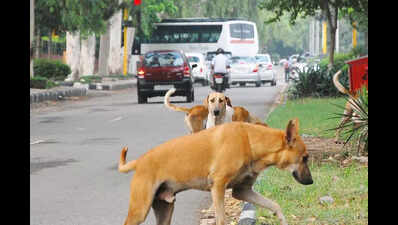Hyderabad: To address the escalating threat posed by violent stray dogs in Hyderabad, Greater Hyderabad Municipal Corporation (GHMC) has urged Telangana High Court to allow euthanasia (mercy killing) as a last resort for dangerous strays.
GHMC top officials explained that these dogs are causing fatalities and severe injuries, especially among children and vulnerable communities. The civic body said the measure would be undertaken only under strict legal and veterinary supervision, to save lives and ensure public safety.
In an affidavit filed before a bench led by acting Chief Justice Sujoy Paul and Justice Renuka Yara, GHMC commissioner K Ilambarithi said, “We are working relentlessly to contain the dangers posed by violent stray dogs, which are taking lives, particularly those of children from disadvantaged backgrounds who play in common public spaces.” The court took suo motu notice of the matter after a four-year-old boy was mauled by a stray dog in Amberpet in Feb 2023.
Ilambarithi highlighted that despite spending crores of rupees on sterilisation and taking preventive measures through animal welfare NGOs, the population of strays — especially violent ones — remains unmanageable. “The rise in stray dog numbers, especially violent ones, is a nationwide issue,” Ilambarithi said, acknowledging that sterilisation alone does not address the violent nature of these animals.
The court had previously raised concerns about the sterilisation process, asking how it could resolve the issue of violent behaviour. Ilambarithi responded that while sterilisation is essential, it does not reduce the aggression of some strays. He added that violent dog attacks pose a grave danger to the public, especially to vulnerable groups like children, elderly people, and slum dwellers, who often use public spaces.
“Stray dog attacks not only lead to fatal injuries but also contribute to traffic accidents, especially involving cyclists and pedestrians,” Ilambarithi said. The commissioner emphasised that the right to life, guaranteed under Article 21 of the Constitution of India, is paramount and govt’s duty is to protect citizens from harm, including attacks by stray dogs.
Ilambarithi also referred to international practices, such as those in UK and US, where euthanasia is legally allowed for stray dogs posing a significant risk to public safety. He cited Environmental Protection Act of 1990 in the UK, which mandates the humane destruction of unclaimed strays, as a model for similar action in India under existing laws.
The GHMC chief clarified that they were not resorting to euthanasia without exhausting all other options. The corporation has been conducting mass sterilisation and anti-rabies vaccination for street dogs. It has established five animal birth control centres and engaged a range of veterinary professionals and dog handlers. The GHMC has identified hotspots where stray dogs are most concentrated, including schools, playgrounds, and public areas, for sterilisation and vaccination.
In line with national guidelines and the Animal Welfare Board of India’s recommendations, GHMC has already sterilised over 80% of the stray dogs in its jurisdiction—one of the highest sterilisation rates among metropolitan cities in India. The corporation continues its efforts to catch and vaccinate all unsterilised dogs, aiming for full vaccination against rabies and population control.
In response, HC granted three weeks for animal welfare activists and officials to submit their replies to GHMC’s affidavit. The case was adjourned to Feb 25 for further hearings.








